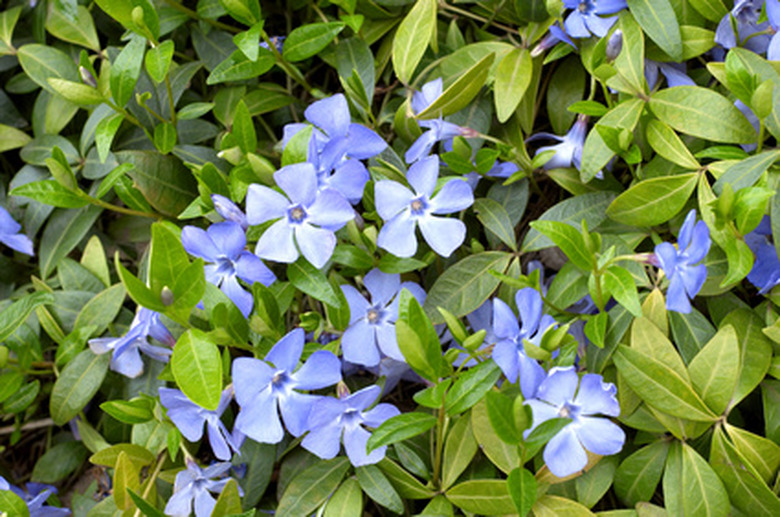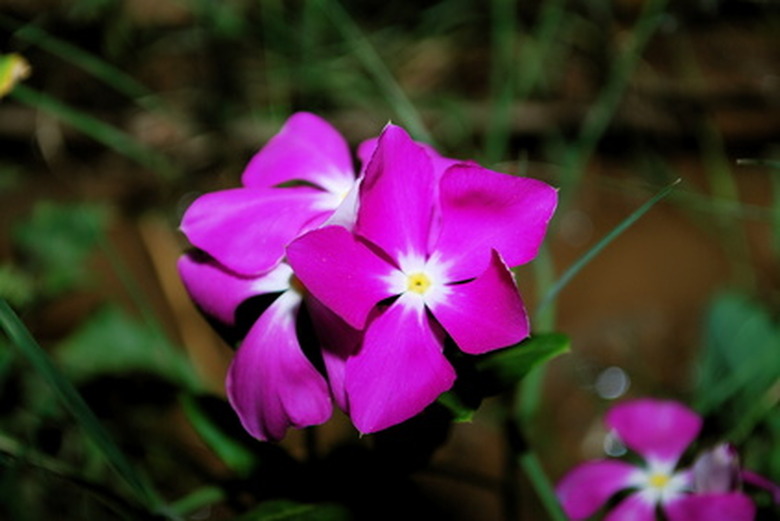Vinca Vs. Annual Periwinkle
The vinca group of plants provides a wide variety of options to suit a range of garden needs across the U.S. Vinca minor is a particularly popular, low-growing vine that serves as a ground cover. Annual periwinkle, on the other hand, is an upright flowering plant for use as bedding flowers or in containers. These two plants may exist in the same family, but differ greatly in growing habit.
Vinca Minor Characteristics
The glossy green leaves of vinca minor give a key to one major difference between these two plants.: Vinca minor is an evergreen ground cover. Mature plant height reaches about 6 inches and produces beautiful purplish-blue flowers in early spring. Vinca minor foliage is oblong in shape; it shares this leaf trait with annual vinca. Vinca minor prefers full to partial shade and grows as a perennial in USDA hardiness zones 3 to 8. Vinca minor doesn't produce another round of blooms after early spring and is mainly prized for its foliage.
- The vinca group of plants provides a wide variety of options to suit a range of garden needs across the U.S. Vinca minor is a particularly popular, low-growing vine that serves as a ground cover.
Annual Periwinkle Characteristics
Annual vinca (also called Madagascar vinca) produce very similar leaves to the vinca minor. Glossy, dark green foliage enhances the beauty of these upright annual plants. This type of vinca likes full-sun locations and is commonly used in container gardens. Vinca periwinkle grows up to 12 inches in height and generates lovely, long-lasting flowers in a wide range of colors. This plant prefers well-drained soil and warm weather. Annual vinca will die after exposure to the first frost in the fall.
Considerations
Vinca minor offers the gardener a hardy option for a ground cover under trees or in difficult planting situations. Annual periwinkle provides a low-maintenance option for a wide range of garden uses. Use annual periwinkle as border plants, in hanging baskets or in window boxes. Annual vinca is an extremely low-maintenance plant that doesn't even require deadheading to remove spent blooms.
- Annual vinca (also called Madagascar vinca) produce very similar leaves to the vinca minor.
- Annual vinca is an extremely low-maintenance plant that doesn't even require deadheading to remove spent blooms.
Soil Preparation
Both vinca minor and annual periwinkle prefer organically rich soil. Incorporate a few inches of compost or peat moss into the garden bed before planting, to boost flower production and the health of these plants. Fertilize container-grown annual vinca regularly to promote full foliage. Vinca minor also benefits from the application of a balanced water-soluble fertilizer application once a year.
Limitations
Annual vinca cannot tolerate the cooler soils of late spring and is quite susceptible to frost damage. Wait until soil and air temperatures warm, to limit yellowing of leaves and keep the plant strong. Vinca minor develops yellowed leaves if placed in full-sun locations. Both plants experience yellowing of leaves if planted in overly wet soil.
- Both vinca minor and annual periwinkle prefer organically rich soil.
- Vinca minor develops yellowed leaves if placed in full-sun locations.

